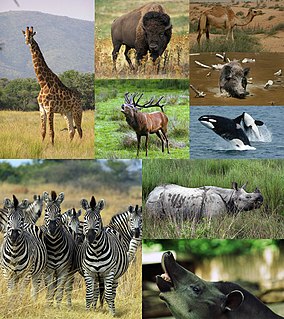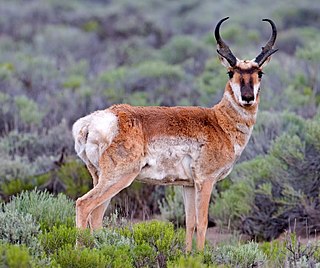
Odd-toed ungulates, mammals which constitute the taxonomic order Perissodactyla, are animals—ungulates—who have reduced the weight-bearing toes to three or even one of the five original toes. The non-weight-bearing toes are either present, absent, vestigial, or positioned posteriorly. By contrast, the even-toed ungulates bear most of their weight equally on two of the five toes: their third and fourth toes. Another difference between the two is that odd-toed ungulates digest plant cellulose in their intestines rather than in one or more stomach chambers as the even-toed ungulates do.

Ungulates are members of the diverse clade Ungulata which primarily consists of large mammals with hooves. These include odd-toed ungulates such as horses, rhinoceroses, and tapirs; and even-toed ungulates such as cattle, pigs, giraffes, camels, sheep, deer, and hippopotamuses. Cetaceans such as whales, dolphins, and porpoises are also classified as even-toed ungulates, although they do not have hooves. Most terrestrial ungulates use the hoofed tips of their toes to support their body weight while standing or moving.

The even-toed ungulates are ungulates—hoofed animals—which bear weight equally on two of their five toes: the third and fourth. The other three toes are either present, absent, vestigial, or pointing posteriorly. By contrast, odd-toed ungulates bear weight on an odd number of the five toes. Another difference between the two is that even-toed ungulates digest plant cellulose in one or more stomach chambers rather than in their intestine as the odd-toed ungulates do.
Condylarthra is an informal group – previously considered an order – of extinct placental mammals, known primarily from the Paleocene and Eocene epochs. They are considered early, primitive ungulates. It is now largely considered to be a wastebasket taxon, having served as a dumping ground for classifying ungulates which had not been clearly established as part of either Perissodactyla or Cetartiodactyla, being composed thus of several unrelated lineages.

Uintatheriidae is a family of extinct ungulate mammals that includes Uintatherium. Uintatheres belong to the order Dinocerata, one of several extinct orders of primitive hoofed mammals that are sometimes united in the Condylarthra.

The Antilocapridae are a family of artiodactyls endemic to North America. Their closest extant relatives are the giraffids with which they comprise the superfamily Giraffoidea. Only one species, the pronghorn, is living today; all other members of the family are extinct. The living pronghorn is a small ruminant mammal resembling an antelope.

Protungulatum is a extinct genus of pan-euungulate mammals within extinct family Protungulatidae, and also one of the earliest known placental mammal in the fossil record, that lived in North America from the Late Cretaceous to early Paleocene.

The Cetruminantia are a clade made up of the Cetancodontamorpha and their closest living relatives, the Ruminantia.
Parictis is an extinct arctoid, possibly the earliest genus of bears known. Though a recent variety of morphological evidence links amphicynodontines with pinnipeds. It was a very small and graceful arctoid with a skull only 7 cm long. Parictis first appeared in North America in the Late Eocene, but it did not arrive in Eurasia until the Miocene. Some suggest that Parictis may have emigrated from Asia into North America during the major sea level low about 37 mya, because of the continued evolution of the Amphicynodontinae into the Hemicyoninae in Asia. Although no Parictis fossils have been found in East Asia, Parictis does appear in Eurasia and Africa, but not until the Miocene.

Mesonychidae is an extinct family of small to large-sized omnivorous-carnivorous mammals. They were endemic to North America and Eurasia during the Early Paleocene to the Early Oligocene, and were the earliest group of large carnivorous mammals in Asia. They are not closely related to any living mammals. Mesonychid taxonomy has long been disputed and they have captured popular imagination as "wolves on hooves," animals that combine features of both ungulates and carnivores. Skulls and teeth have similar features to early whales, and the family was long thought to be the ancestors of cetaceans. Recent fossil discoveries have overturned this idea; the consensus is that whales are highly derived artiodactyls. Some researchers now consider the family a sister group either to whales or to artiodactyls, close relatives rather than direct ancestors. Other studies define Mesonychia as basal to all ungulates, occupying a position between Perissodactyla and Ferae. In this case, the resemblances to early whales would be due to convergent evolution among ungulate-like herbivores that developed adaptations related to hunting or eating meat.
Eomoropidae is a family of odd-toed ungulates, a group which also includes horses, rhinoceroses, and tapirs. They were most closely related to the extinct chalicotheres, which they greatly resemble, and may have been their immediate ancestors. They were, however, much smaller than the later forms, being around the size of a sheep. Like their later relatives, they were probably browsers on leaves and other soft vegetation, and, unlike most other ungulates, had claws on their feet. The Eomoropidae is most likely a paraphyletic group within Chalicotherioidea.

Leptomeryx is an extinct genus of ruminant of the family Leptomerycidae, endemic to North America during the Eocene through Oligocene 38–24.8 Mya, existing for approximately 13.2 million years. It was a small deer-like ruminant with somewhat slender body.

The pronghorn is a species of artiodactyl mammal indigenous to interior western and central North America. Though not a true antelope, it is known colloquially in North America as the American antelope, prong buck, pronghorn antelope, prairie antelope, or simply antelope because it closely resembles the antelopes of the Old World and fills a similar ecological niche due to parallel evolution. It is the only surviving member of the family Antilocapridae.

Ramoceros is an extinct genus of the artiodactyl family Antilocapridae endemic to Middle Miocene (Clarendonian) North America.

Artiofabula is a clade made up of the Suina and the Cetruminantia. The clade was found in molecular phylogenetic analyses and contradicted traditional relationships based on morphological analyses.

Phenacodontidae is an extinct family of large herbivorous mammals traditionally placed in the “wastebasket taxon” Condylarthra, which may instead represent early-stage perissodactyls. They lived in the Paleocene and Eocene epochs and their fossil remains have been found in North America and Europe.

Merycodus is an extinct genus of the artiodactyl family Antilocapridae. Fossils of this genus have been found in the Santa Fe Group of New Mexico.

Barylambdidae is an extinct family of pantodont mammals from North America.
Lambertocyon is a genus of ungulates from western North America. Three species are known, making their last appearance in the Late Paleocene Clarkforkian stage.
Paracosoryx is an extinct genus of antilocaprid that lived in North America during the Miocene.
Byers, John A.; American Pronghorn: Social Adaptations & the Ghosts of Predators Past; University of Chicago Press; 1998

















